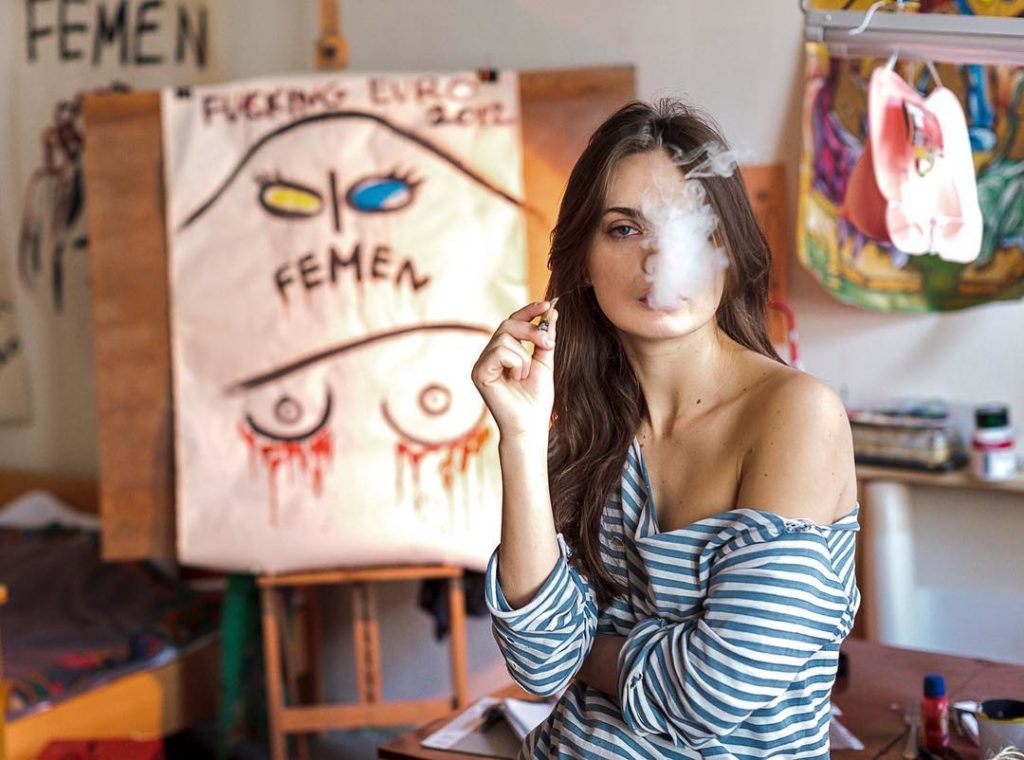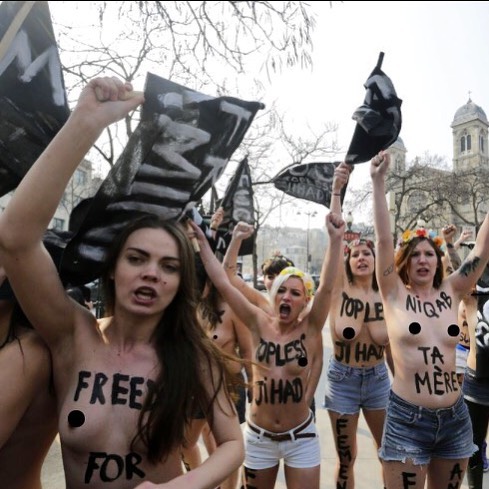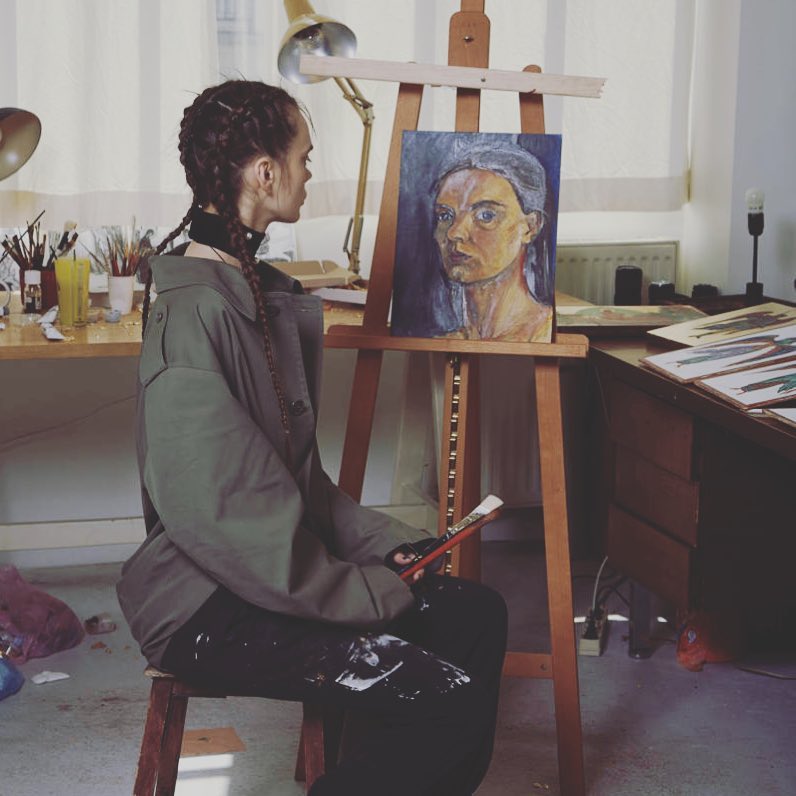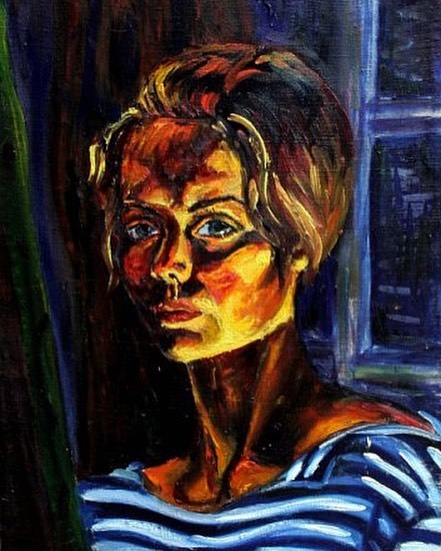Oxana Shachko told me she preferred that spelling, with the “x,” in 2016, as I was finalizing an essay that would describe, among other things, her life. In news articles about her, which have multiplied since her death in Paris this July, a suicide, journalists more typically use the Romanization “Oksana.” I will stick with the spelling she and I agreed on even though I knew Oxana, an artist who was 31, to take things like this lightly, often changing her mind.
My essay dealt with the women’s group Femen, which Oxana helped to found in Ukraine. Beginning in 2008, it protested corruption in government; the conscription of Ukrainian women into sex work, which Oxana described as an issue of poverty, of globalization, even; and the failings of the hospital in Khmelnytskyi, of the Kyiv zoo. By 2013, the founding members all lived in exile. Oxana and another co-founder, Sasha Shevchenko, had fled to France, where they would become political refugees. The third, Anna Hutsol, went to Switzerland, where she was denied asylum. By the time I met Oxana in Paris, Femen had added activists internationally. The group had attracted attention in the West for its performative topless protests as well as for a certain overreach, taking on issues as far afield as the situation of women in Muslim countries. It would have surprised people I knew in Paris, where Femen was famous, that these women had begun with issues local to Ukraine.
My memory is that Oxana left Femen in 2014, and that even then she showed ambivalence. (She’d say, for example, that she affiliated not with Femen France but with a Femen International.) In later accounts, the date moves up. A 2016 text published by a gallery that showed her says she left the group in 2013.
I am wary of making too much of slippages like this, particularly in retrospect. Still, if Oxana’s life did, on occasion, reshape itself, as she had many occasions to tell of it, her death has cluttered the truth further. Web searches turn up the work of artists less accomplished than she was, the photographers and filmmakers who shot her. If you didn’t know her, you might struggle to identify the paintings that were hers. She was born in Khmelnytskyi, which is in western Ukraine, where, at the exceptionally young age of 8, she apprenticed herself to a Greek man who painted icons. A deeply religious child, she came to identify as an atheist, a materialist, a communist, and, at last, a feminist. In her late paintings, her technique with gold leaf, with the tempera she herself made out of egg yolk, translates into a political vernacular. Madonnas, haloed, wear niqabs. An archangel is gay, as denoted by a rainbow. Jesus and fishermen float in a comfortable boat as, below them, hands reach up to break the waves. They are the hands of humans sinking, which the sanctimonious men ignore.
She was generous, and she learned to relax into her beauty, a quality she hadn’t always valued but which others liked. She allowed herself to be photographed, though the glamor shot was not natively her thing. A few of them she’d reproduce on her own Instagram: from what seems to be a Russian fashion magazine; from the French photographer who staged her gazing back at him head-on, a bombshell. She did love to play dress up. In Ukraine, as the group’s artist, she made its signs, masks, banners, costumes. In Alain Margot’s documentary starring her, I Am Femen, which I watched with Oxana in the basement of the Centre Pompidou, Oxana lugs a ream of burlap someplace, pushes it against a snow bank, sets it afire, stamps out the fire, and turns to the camera with a big grin: “Haute couture!” The scene, in which apparent violence resolves into a joke, represents her as I knew her. In a 2016 video by the German arts magazine 032c, she is, again, herself, tossing her head and spinning in her chair. She’s speaking in Russian, though I always associated her hyperactivity with her resourcefulness in communicating. She came to Paris with little French and learned it as she was learning English, so that as we spoke in English she’d repeat herself, offer French synonyms, emphasize things liberally, wave her arms demonstratively, and, frequently, slap her forehead. (“Jeune communiste, you know? When you can’t be communist because you are too young.”) In the video, she discusses, in voiceover, her flight from Ukraine, where she faced charges of terrorism, and, grimly, the watering down of Femen in the West, where it came under the direction of activist Inna Shevchenko (no relation to Sasha). Oxana brandishes a toy gun campily, pours out vodka, downs it, and wolfs shredded cabbage. Above her leans one of her icons, an archangel holding a Kalashnikov. She goes on to speak of her depression in France, and her double, the visual, lies supine in a frou-frou dress, wearing tons of makeup, listlessly eating from candy necklaces she wears.
In addition to Oxana’s obvious beauty, the video shows her familiarity, her easy physicality. She had delicate, even babyish features, high cheekbones, wide-set eyes, little teeth. Given to work clothes that drowned her, she was by any measure extremely petite. This July she managed, in a gray suburb south of Paris, to hang herself. I know those buildings. They are not cathedrals. She hanged herself in the wardrobe, according to Libération’s quote from Apolonia Sokol, a painter who was one of her best friends. Shortly before her death, Oxana made a post to Instagram that is, in my experience of her, uncharacteristically ugly. It is a painting, black and green capitals. “You are fake,” it says—Oxana said.
*
I met Oxana when she was 26 and I was 23. Today, I’m not sure I’d have chosen Femen for a subject. From the start, I had a horror of the notion that I’d wind up apologizing for the Islamophobia, or for the abolitionism vis-à-vis sex work, for which the group was, fairly or not, known. In 2013, I was conducting an open-ended project of reporting in squats in Paris, on the occupation of buildings. That fall, a friend who was a housing-rights activist asked if I wanted to join him in opening a squat. I had travel plans for that weekend, and I changed them. He was liberating a vacant water-treatment facility in Clichy, specifically to house the Femen activists who’d recently arrived from Ukraine, though it would also take in squatters who were homeless for other reasons. I hadn’t heard of Femen at the time. I found the activists on YouTube, doing militaristic push-ups. I met them in the night of October 31, which they may or may not have known was American Halloween, and helped them to move boxes and furniture from the Lavoir Moderne, a theater in Paris’s Eighteenth Arrondissement where they all then were staying, into a van. Oxana, a quick study, had better English than some of the other girls, and she was my first friend. In that weekend’s notebook, which includes a menu like a doodle—“sardines on rice cakes, Nutella on rice cakes, coffee”—I find my note that Oxana called me, having temporarily absented the building, only to quickly, abstractedly conclude, “Say hello to everyone,” though we’d all only just met, the “h” in her accent practically Hebraic. (I also took down her admonishment that I learn Russian so as to read the classics in the original, a task I still haven’t gotten around to.) She was gracious in inhabiting these post-hoc homes, which were half natural, full of light. They suited her informality, the breadth of her gestures, her basic forthrightness. In high school she’d left her parents’ house to live in a cottage of clay that had been her grandfather’s. It had no plumbing, and she fixed it up. Other squatters found furniture on the sidewalk; Oxana found, somehow, a juicer, and juice became her habit. The apartment in which she died was not a squat. It seems to have been a place she was renting outright, where she lived alone.
In 2014, after a disagreement with the new, French Femen, who, at the squat, broke down Oxana’s bedroom door, she moved back into the Lavoir Moderne, which was by then resisting its own eviction. She thundered downstairs to meet me: smock and jeans blotched with paint, hair stuck with pencils. Two weeks earlier, a man had interrupted a performance at the theater, yelling about Femen. (It was well known in France that they’d all lived there.) He knifed two spectators. Oxana and Apolonia, who was living there, too, had unusually, and only by chance, locked the door to their living quarters. Oxana showed me where among the theater’s balding seats the man had stood. The hero of the night was a guy who’d been loitering outside and confronted the attacker, which the police who interviewed Oxana could not understand. Their hypocrisy was, for her, the point of interest. They had failed to believe her because the man looked like any other in the streets of the Goutte d’Or, a French-African neighborhood. The racism of the police was, for Oxana, a form of hypocrisy. Fakeness entailed all that, in her view.
In September of last year, Oxana and Sasha appeared on a book cover. Per Olivier Goujon’s Trahison, “Betrayal,” which I have not read, Inna, who got to France first, took all credit for the group’s success and led it dictatorially. This story, which Goujon touted as untold, authentic, had in fact already taken on, in the French press, dimensions as melodramatic as any of the tales it tells about Femen. In 2014, l’Obs reported that Inna’s father, a colonel, had, when she was a baby, daily poured ice water over her, with the intention of hardening her. I’m not on Inna’s side. My friends were Oxana, Sasha, and their friend Yana Zhdanova, all of whom publicly disaffiliated from her group. Still, I dislike how the story seats evil in Inna. In my observation, there were others to blame for shifts in the Femen agenda, for its loss of focus, like the ex-Charlie Hebdo polemicist Caroline Fourest, who’s often accused of Islamophobia, and who wrote adoringly about Inna as the group’s leader. Inna has gone on to lecture against religion in the way that serves those Western Europeans who apply their principle of secularism to Islam with disproportionate stringency, and who bait anti-immigrant sentiment.
Despite these personal and ideological conflicts, Oxana described the Femen schism in aesthetic terms, which for her could describe anything. She called Inna and her followers in France too “fashion,” too “fake.” “They copied the protest,” she told me in 2016, “they write the slogans on the breasts, but it’s without sarcasm. Our actions were very dangerous, very serious, but we always laugh. Like, why are we naked?” The artistic differences between Oxana and Inna predated their time in France. In FEMEN, Galia Ackerman’s 2013 biography of the group, Inna insists that what they do is not art. It seems she thought that Femen would be taken more, not less, seriously, if they pretended their breasts were literal weapons. Oxana’s response, for its humility and clarity, bears reproduction. It presages a preoccupation she shared with me in Paris about real art, as compared with fakes.
Are we creating art? One year ago, we were still having quite a few arguments over this. The girls accused me of having said in an interview that we were artists. I defended my point of view. I think that true artists—I’m not talking of artists daubing canvases and then selling them as merchandise—are not passive figures. The main task of art is revolution. We call for a revolution: one person will use music, another painting, another her own body. An artist is always a revolutionary. I hope this is true in my case.
In fact, there was humor in the France protests, but unlike with the Ukraine protests, the women did not control it. It was the relative ridiculousness of their nudity in the West, where the stakes of the war they claimed to wage on “dictatorship” appeared, at least during the Obama years, low. It was, also, the dark irony that befalls people we name in terms of movement—migrants, drifters, travelers, the stateless—but whom laws and rules confine more completely than they do any other subject. There was an important happening that Oxana had to skip in order to keep an appointment with Immigration.
Is it ethical to write about a suicide framed, by Oxana’s Instagram post, as martyrdom? I had been silent, murmuring, for most of the portion of interview I’d taped. But at that I became enthusiastic, replying ingenuously—I find it embarrassing to listen to myself—that it was the same with writing. “You work and work to say something clear.”
An explanation Oxana once gave for the group’s toplessness was the only one I ever understood: “Nudity was an allusion to our poverty.” The documentary I Am Femen, which covers the years before Oxana’s arrival in Paris, shows her after she allegedly was beaten by Belarussian secret police, having protested that country’s government outside KGB offices in Minsk, and after she broke both forearms in jumping from a wall, convinced the men following her were the Ukrainian state’s own thugs. Even so, she is never so upset as when relating that, in jail in Moscow, she was told her one phone call had to be local. She couldn’t call her mother. Her mother is interviewed, too, put out but doing a favor. With an air of obligation, she tells the filmmaker that her daughter is like Joan of Arc. “I couldn’t do it,” she says then, gushing. “All I can do is knit.” She giggles as suddenly as Oxana sometimes did. “All I can do is love her. I can only give her my love.” Oxana’s father suffered from alcoholism; her mother speaks of Oxana as a “man” who customarily consoled her. Oxana is shown on the train, unwrapping home-cooked food with which her mother has saddled her, comic in its sheer quantity. When, in 2016, 032c asked Oxana if she felt at home in Paris, she drew a contrast between home, which she understood in terms of her mother, and freedom. To me, she said she hoped it was not paranoia, but she believed she’d be in real danger if she returned to Ukraine as an activist. Ultimately, as a political refugee, she could not go home. Her Instagram, with its “fashion” photos, begins as this status is officialized, her first post the French document for which she had waited. “I say it is only possible to feel at home at your mother’s home,” Oxana tells 032c, in the magazine’s translation, “so for me, it is more important to feel myself free.”
*
Is it ethical to write about a suicide framed, by Oxana’s Instagram post, as martyrdom? Wondering about this, I get up from my computer. I haven’t been outside. I go out to get my laundry, and the clouds are pink and gold, like a tint of hers.
I last saw Oxana in March of last year. I met her and Yana at an exhibit in the Eighth Arrondissement, where all the cafés were boring, expensive, but we wanted at least to sit outside. We found a terrace on the main road, below a monument that may have been the Chapelle Expiatoire. It was lit up, and we sat in its glow. Oxana had come straight from Brussels, where she’d exhibited her paintings. She was dragging a cloth shopping trolley, her luggage. As I recall, she merrily pronounced herself so disheveled that we’d all be kicked out, and Yana, instead, went inside for menus. We got glasses of wine. We couldn’t stay late. I forget why. I, for one, was jet-lagged, and glad I could tell Oxana I’d stayed up till 7 or 8 that morning writing, enjoying the freedom of displacement in time. It was easy for us to laugh at each other. She didn’t have the paintings. She’d left them in Brussels, she’d had to, for another time.
Where are her paintings? Which fake will acquire them? She chose to die in the wardrobe. Her body was clothing that no longer fit, something dirty she stepped out of. I revisit her critique of the France protests: too obvious, too humorless, “even ugly,” lourd, dure. I want, now, to throw it in her face, which isn’t there. As a performance of my anger, this lacks for audience, like “You are fake,” its “you” left vague. To say that Oxana’s last Instagram post did no honor to her thinking around authenticity would be to miss the point. Let me return to a discussion of her life.
When, at the Lavoir, I suggested to Oxana that imagining a new society was a creative process, she said: “For three years I write the slogans on the body of the girls.” I replay I Am Femen, fascinated by the footage filmed before I knew any of them, before their exile. Oxana is survived by Yana, who was prosecuted for exhibitionism in France after a topless protest; by Sasha, who became a mother; by Anna Hutsol, among others, and by Inna. In I Am Femen, Oxana surprises some of these women. In Ukraine she’d habitually skipped functions, telling the others she had nothing to wear. The camera reveals her in a pink dress, enormous fedora, and six-inch heels, the stickers still on, falling all over. The others, at the buffet table, lose it. Inna bends to kiss Oxana’s hand and laughs into the hand. In contrast to many Femen protests, there is, I think, something like a play on gender in Oxana’s drag performance. It is directed, with perfect sureness, at her friends.
Jacqueline Feldman is a writer living in New York. Her essays appear in Real Life, The White Review, and elsewhere.
from The Paris Review https://ift.tt/2OOvyHV





Comments
Post a Comment